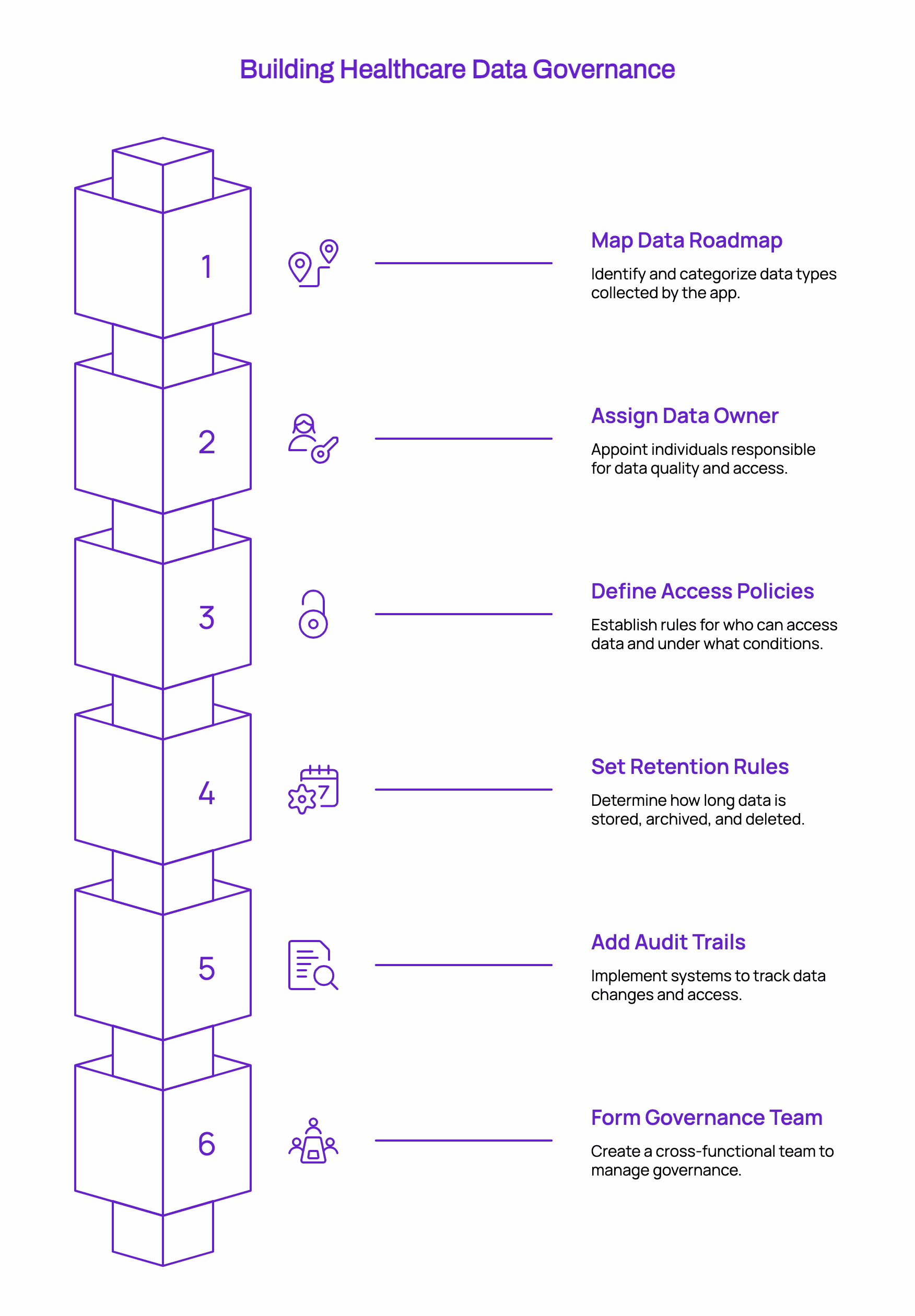Data in HealthTech is highly sensitive, regulated, and massive.
We’re talking medical records, lab results, insurance info, even data from wearables. And there are strict rules to follow. HIPAA, HITRUST, CCPA, CPRA, and the 21st Century Cures Act, to name a few.
The consequences of data-related blunders can be serious.
That’s why you need strong data governance. It helps you stay in control. With clean data, clear rules, and the right access, your team can work faster and smarter. All without risking user trust or breaking the law.
In this post, we’ll show you how to build a solid data governance setup. One that’s ready to scale, easy to manage, and built for compliance.
What Data Governance Means for Your HealthTech App?
Data governance in healthcare varies from company to company. It depends on what your app does, how much data it handles, and how that data flows between systems.
However, at its core, data governance sets the ground rules. It’s how you decide:
- Who owns the data
- Who can access what
- What qualifies as sensitive or protected
- How long should data be kept
- What happens when data is deleted, shared, or updated
Data quality is another priority concern. Messy data causes real problems. Think bad decisions, broken features, and compliance issues. In healthcare, that’s a big deal. One mistake can affect someone’s life.
As of 2025, 71% of surveyed organizations report having an active data governance framework, up from 60% in 2023, showing how essential governance is becoming for compliance, quality, and scalability.
Say you’re building a small symptom-tracking app. You might get away with a light setup. But if you’re working with EHRs, insurance claims, or years of patient data, you need a solid plan from the start.
The key is clarity. You don’t need a 200-page rulebook. You just need a few simple rules that actually work and grow with your product.
Lay the Groundwork: Build a Healthcare Data Governance Framework

Start by mapping out your data roadmap with this simple question: What kind of data does your healthcare app collect?
Is it patient vitals, appointment history, insurance IDs, genomic data, or IoT sensor feeds? Group them into categories like PHI (Protected Health Information), PII (Personally Identifiable Information), and operational data.
Then, put structure around it:
- Assign Data Owner: Someone accountable for the quality and access of each data set.
- Define Access Policies: Who gets to see what, and under what conditions.
- Set Retention Rules: How long data is stored, when it’s archived, and how it’s deleted.
- Add Audit Trails and Version Control: So you know who touched what and when.
If your app touches clinical workflows or integrates with hospital systems, create a small cross-functional team to manage governance. Get your engineers, compliance leads, and data analysts aligned early. A Data Governance Council, even if informal, keeps policies relevant and updated.
It doesn’t have to be overkill. It has to be intentional. Good governance is your safety net as your app scales and user base grows.
Ensure Regulatory Compliance From the Start
Health data is some of the most tightly regulated information on the planet. If you’re not thinking about healthcare compliance early, you’ll be patching holes later. This will get expensive fast.
Beyond regulations, healthcare teams must also address the ethical challenges in AI-driven healthcare to ensure compliance aligns with fairness, transparency, and patient trust.
So, it’s a good idea to understand the basics of all the major regulations and how they tie back to governance.
HIPAA
Covers the privacy and security of health information. Applies if you’re storing or transmitting any Protected Health Information (PHI). Your app needs:
- Access controls
- Encryption in transit and at rest
- Breach notification processes, which map directly to your access policies, data classification, and audit logging
HITRUST CSF
Not a law, but a widely adopted healthcare data governance framework that brings together HIPAA, NIST, ISO, and others. It’s how many enterprises (hospitals, payers, or pharma companies) judge if your system is truly secure.
Your governance model should mirror HITRUST’s layered controls, from technical safeguards to policy documentation.
Suggested Read
HITRUST vs. HIPAA: Key Differences, Benefits, and The choice
View Blog
CCPA and CPRA (California)
Give users the right to access, delete, and restrict personal data. The CPRA expands on the CCPA with stricter rules regarding sensitive health data. In terms of governance, you need data subject request workflows, clear retention timelines, and opt-out consent flags.
21st Century Cures Act and ONC/CMS Final Rules
These mandate interoperability and give patients easier access to their health records through APIs. It requires ensuring standardized, secure data exchange across health systems and real-time patient access to health records, especially through FHIR APIs.
In simple words, make sure your system supports interoperability, data transparency, and API-level controls.
GDPR
Applies if you have users in the EU, even if you’re based elsewhere. You’ll need:
- Lawful basis for data processing
- User consent management and privacy controls
- Data minimization and lifecycle rules
- A designated Data Protection Officer (DPO) in some cases
PHIPA (Ontario, Canada)
Applies to health information custodians in Ontario. If you serve Canadian providers or patients, PHIPA compliance is a must. Your governance needs to reflect role-based access, audit trails, and timely disclosure protocols.
Ultimately, each of these regulations maps back to your healthcare data governance framework. A few examples:
- You need clear roles and access controls (HIPAA).
- Data classification and encryption (HITRUST).
- User-facing controls and opt-outs (CCPA/CPRA).
- Transparent APIs and audit logs (Cures Act).
Make sure these healthcare compliance requirements are baked into your product and DevOps workflows, not bolted on later. If you build those guardrails into your governance structure now, you won’t have to scramble when auditors, regulators, or enterprise clients come knocking.
Use the Right Tech Stack to Automate Governance
Policies are great. However, without the right tools, they’re mere words on paper.
As your HealthTech product grows, manual governance will fall apart fast. You need systems that enforce the rules automatically across environments, teams, and data pipelines.
Here are a few key areas to focus on when building a governance automation tech stack.
Access Management
Use tools like Auth0, Okta, or your cloud provider’s identity services to enforce:
- Role-based access control (RBAC)
- Multi-factor authentication (MFA)
- Just-in-time permissions
Set it up once, and let the system handle the rest.
Data Catalogs & Classification
Tools like Azure Purview, AWS Glue, or open-source options like Amundsen help track what data you have, where it lives, and who’s using it.
Use them to:
- Tag sensitive fields (like PHI, PII)
- Monitor data usage patterns
- Flag unapproved access
Audit Logs & Monitoring
Enable audit trails at every layer: app, database, infrastructure. Cloud-native options like CloudTrail (AWS) or Stackdriver (GCP) make this easy.
Pair that with SIEM tools like Splunk or Sumo Logic to spot suspicious activity in real time.
Infrastructure as Code (IaC)
Define your environments with tools like Terraform or Pulumi, so every environment (dev, staging, prod) follows the same governance rules.
Interoperability Tools
If you’re working with EHRs or third-party APIs, tools like Redox, 1upHealth, or FHIR-native SDKs can help you integrate while respecting data boundaries and user permissions.
Your goal should be to stack as few tools as you can in your tech stack. Only choose ones that match your scale and risk level to make governance automatic, not reactive.
Done right, your tech stack then becomes a silent enforcer of all the right behaviours.
Enable Scalability Without Compromising Trust
Scaling a HealthTech product means more users, more data, and more integrations. Unfortunately, this also means a much bigger surface area for things to go wrong.
That’s where good governance shows its real value. It keeps your systems from turning into chaos as you grow. Here’s what good data governance looks like in real life:
- Access Stays Clear as Teams Grow: As your team changes, people come and go. Your system should update access automatically based on roles. No more random one-off requests.
- Integrations Follow a Clear Process: New tools or partners mean new risks. Set a simple flow to check security, define what data they can use, and control how much access they get.
- Your Data Model Stays Clean: Use tags and tracking to see where data comes from, how it changes, and who uses it. No more guessing.
- Handovers Between Teams Go Smoothly. Everyone (devs, security, compliance) should speak the same language. Simple rules help teams work together without confusion.
Good governance doesn’t slow things down. It helps you grow fast while keeping your data safe and your users confident.
Build a Culture of Data Responsibility
Tools and policies only go so far. At some point, it comes down to people.
If your team sees data as something worth protecting and something that earns user trust, its governance becomes second nature.
This mindset shift doesn’t happen overnight, but it starts with how you build the culture:
- Improve Onboarding: Don’t just train people on systems. Teach them why governance matters. Show them what a data breach actually costs in trust, time, and revenue.
- Make Policies Accessible: No one’s going to follow a 100-page PDF. Create quick-reference guides, workflows, and checklists that are easy to use and access.
- Encourage Questions: If someone is unsure about a permission or a data flow, they should feel safe asking. That transparency beats shadow access or skipped reviews.
- Celebrate Clean Data Habits: Recognize teams that maintain good naming conventions, document schemas, or clean up unused fields. It sets a standard.
- Review and Evolve: Set regular check-ins not to police, but to learn what’s working and what’s not. Governance should be a living thing, not a frozen policy.
Good governance is enforced and embraced. When your team owns it, trust becomes part of your product’s DNA.
Build Scalable and Compliant HealthTech Software With SoluteLabs
Data governance in healthcare products enables safe growth, fast workflows, and user trust.
With clear roles, strong policies, the right tools, and a team that takes data seriously, you set yourself up for long-term success. At the same time, you avoid compliance headaches, and most importantly, you protect the people who rely on your product.
So don’t wait for your next audit or your first breach to care about governance. And if you’re looking for a partner in this space, you’re in the right place. SoluteLabs helps healthcare startups and enterprises ship secure, scalable, and healthcare compliance-friendly software.
Get in touch with us to build scalable and compliant HealthTech software.







